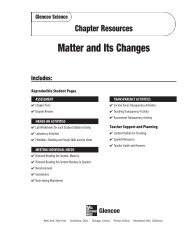Weathering and Erosion - Learning Services Home
Weathering and Erosion - Learning Services Home
Weathering and Erosion - Learning Services Home
Create successful ePaper yourself
Turn your PDF publications into a flip-book with our unique Google optimized e-Paper software.
Name Date Class<br />
2<br />
Laboratory<br />
Activity<br />
<strong>Erosion</strong> <strong>and</strong> Soil Permeability<br />
The permeability of soil, which describes how water can flow through the soil, can be a<br />
contributing factor in erosion. Soil that is very porous can have high permeability. However, if a<br />
soil’s pores are not connected, permeability can still be low. In order for water to flow easily, the<br />
pores in soil must be connected. The porosity of different soils is one factor that determines how<br />
erosion will affect them.<br />
Strategy<br />
You will compare the permeability of three different soil types by conducting “perc” tests.<br />
You will see how soils with different permeabilities are eroded by water.<br />
H<strong>and</strong>s-On Activities<br />
Copyright © Glencoe/McGraw-Hill, a division of the McGraw-Hill Companies, Inc.<br />
Materials<br />
small coffee cans with both ends removed (3)<br />
permanent marker<br />
metric ruler<br />
plastic tubs, about 30 cm ✕ 30 cm ✕ 30 cm (3)<br />
h<strong>and</strong> shovel<br />
s<strong>and</strong>y soil, approximately 2.5 kg<br />
loamy soil, approximately 2.5 kg<br />
clay soil, approximately 2.5 kg<br />
500-mL beaker<br />
water<br />
stopwatch<br />
*watch with second h<strong>and</strong><br />
10-cm wooden block<br />
sprinkler can<br />
*Alternate materials<br />
WARNING: Be sure to wash your h<strong>and</strong>s after touching the materials used in this lab.<br />
Procedure<br />
Part A—Determining Porosity<br />
1. Use the marker to make a line 3 cm from<br />
one end of each coffee can. Label the tubs<br />
S<strong>and</strong>y, Loamy, <strong>and</strong> Clay to designate the<br />
soil types you will be testing.<br />
2. Fill each of the plastic tubs with the type of<br />
soil that corresponds to the label. Use the<br />
shovel to pack down the soil.<br />
3. For each soil type, observe the color <strong>and</strong><br />
texture of the soil <strong>and</strong> presence of any<br />
organisms in the soil. Record your observations<br />
in Table 1 in the Data <strong>and</strong> Observations<br />
section.<br />
4. Predict the permeability of each soil as low,<br />
medium, or high. Record your predictions<br />
in Table 1.<br />
5. Press a coffee can into the s<strong>and</strong>y soil up to<br />
the mark at the 3-cm line. Press a coffee<br />
can into each of the two other soils.<br />
6. Perform a “perc” test on the s<strong>and</strong>y soil by<br />
pouring water in the cans. Have your stopwatch<br />
ready to begin timing when the<br />
water first reaches the soil. Slowly pour 500<br />
mL of water from the beaker into the can<br />
in the s<strong>and</strong>y soil. Stop timing when all the<br />
water has sunk into the soil. In Table 1,<br />
record the amount of time it took for all<br />
the water to sink below the soil surface.<br />
7. Repeat steps 5 <strong>and</strong> 6 for the other two soils.<br />
Try to keep your rate <strong>and</strong> style of pouring<br />
the water the same in each perc test.<br />
<strong>Weathering</strong> <strong>and</strong> <strong>Erosion</strong> 13














